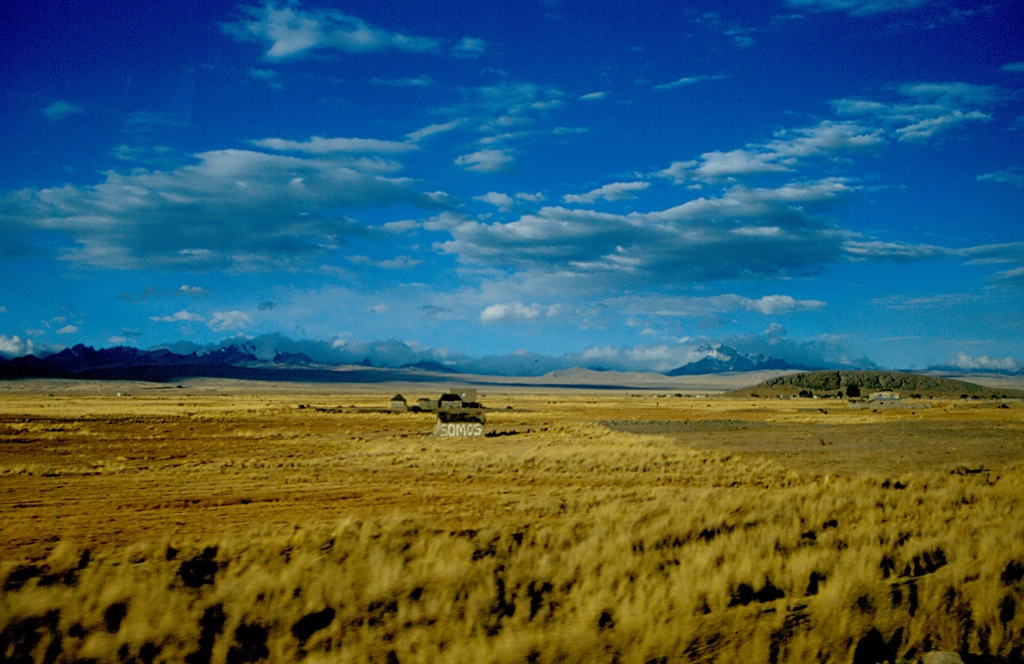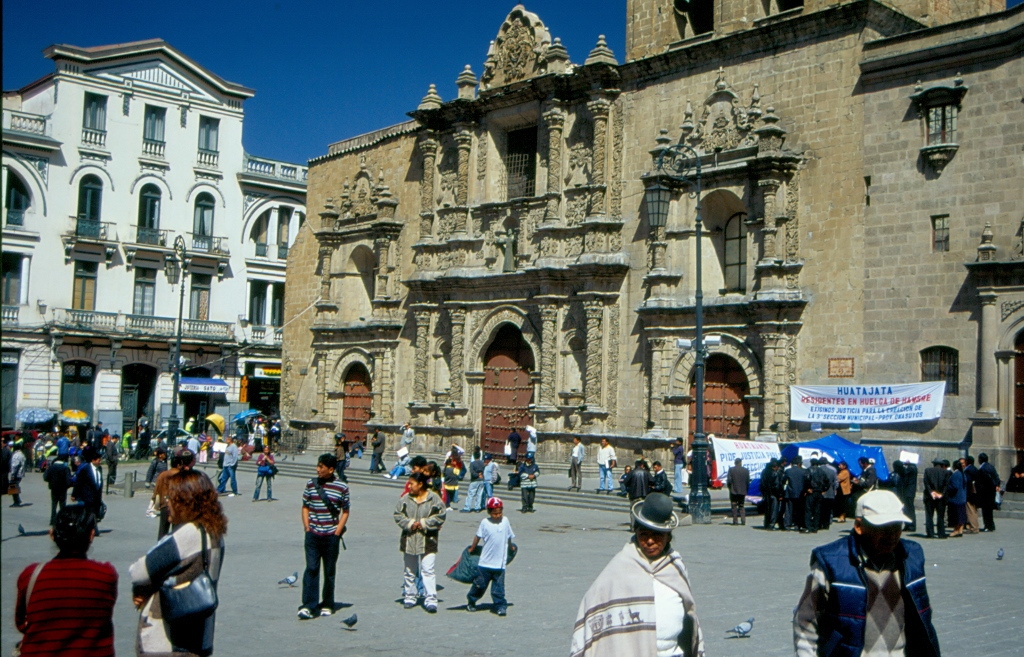The road to La Paz goes literally across the lake of Titicaca. Since the lake is rather wide at this point and there is no bridge, transportation is carried out by pontoon ferries. These are big enough to transport coaches and trucks, let alone the rest. After that, the road ran over a plateau, mountains could hardly be discerned in the distance and everything looked exceptionally beautiful. The landscapes were completely simple, but the sun that had already started to set slowly emphasized the beautiful yellowish-brownish colour of the dried vegetation.
 On the way from Copacabana to La Paz
On the way from Copacabana to La Paz
When I got to La Paz it was already dark. My arrangement for the stay there was quite unusual. Namely, Virginia from Lima told me that she had a good friend in La Paz and that I could stay at his home which he shared with his family. That friend was Jose Duran and Virginia gave me his email address. While I was travelling from Lima to La Paz, I managed to establish a contact with Jose and explained to him who I was and he indeed told me that I was welcome to stay at his place. Admittedly, as he told me, he would not be home on the days I planned to come to La Paz, but there would be no problems. He just sent me the address and told me that all I had to do was to get to the house where his mom, a brother and a sister lived and they would receive me. Just like that.
And thus, completely at ease I got into a taxi and gave the address to the driver. He drove and drove, and we kept going down and down and then he finally brought me to the house. I got out of the taxi, with my bag and all, and stood in front of the gate to observe the situation. Like a vast majority, or probably all the houses, this one also had a high fence consisting of a gate made of metal bars and a wall on the sides of the gate. The house and the entrance into it were further down a passage that could accommodate a parked car. Everything was in the dark. I did manage to find a bell next to the gate, so I pressed it. Nothing. Well, at this point I became completely puzzled. It was already around 8 o’clock in the evening, I had no alternative reservation, I had no idea where I was and I was generally without a clue as to what to do next. So, I waited for a little while longer and then I pressed the bell again. Again nothing at first, but then a person I could barely glimpse because of the dark appeared at the house door and I started to shout from some 15 metres away explaining that Virginia from Lima referred me to Jose, and then Jose told me that I could come, and so I came. And then that person went back into the house and I, still perplexed, remained there in front of the gate. And then finally a young man came out and invited me in. It was Gustavo. I started to explain anew who I was and where I came from, and he took me through the house to the backyard where there was another smaller house and he told me to leave my things there. Since he had some pressing obligations, he took me to Jose’s room, turned on a TV and told me to watch whatever I wanted, while he finished some work in the meantime.
And so this was what happened. While Gustavo worked, I watched some American film. Although it’s far from being my favourite film, to this very day whenever I see it on TV I always think of my first night in La Paz and I get a warm feeling around my heart. When Gustavo finished with what he was doing, we went downtown for something to eat, but beforehand we stopped at a friend's of his in order for Gustavo to hand him over the job he did. Gustavo and I hit it off at once and we really had good time that evening, but I was glad when we got back home eventually which allowed me to catch up with my sleep. The house I was placed in consisted of a small two-room dwelling and all of it was at my disposal.
In the morning, after breakfast, Gustavo and I went to his tango lesson. I wanted to see that and I liked the idea of filming it. However, when we got there, it turned out I was expected to dance. Needless to say, I had never danced tango before, but this apparently created no impediment, for there were other beginners, too. What was good was that as a pure chance I wore shoes with leather soles and not trainers or hiking boots, so although these were not proper dancing shoes, I could still reasonably decently move in them across the parquet. The room where we danced was really phenomenal. An old spacious salon and although the floor boards cracked as people moved over them, this did nothing to lessen its beauty and grandeur. When Gustavo first started to insist that I danced, I declined the invitation initially, but when I started with the first step I was completely and absolutely delighted and I could not take a smile off my face. Tango is a magically beautiful dance and I particularly rejoice in the fact that my first tango lesson was precisely in La Paz.
Afterwards we went with some friends from the tango class to eat salteñas. Salteñas are great food – baked dough like small pillow cases filled with beef or chicken in sauce. Exceptionally tasty, but require a special eating technique as the sauce is liquid and tends to mess up whoever is eating them. However, I must have been a Bolivian in some of my past lives, for I ate them without any consequences to my wardrobe. In addition to the good food, the people I was with were a lot of fun and we really had great time together. While sitting in the restaurant I heard some old Spanish song which I always liked, so they told me the name of the song and the singer. Later I bought a CD with the song which again reminds me of La Paz and this fantastic group of people.
Still, after a while we parted from them. Gustavo and I first went for a short walk and then we went to visit his friend Raquel, her husband Stefano (an Italian) and their little boy. They had just returned from a trip to Europe, so we initially chatted about that and then they proposed to lend me a backpack for my travel around Bolivia, as that would make it easier for me to move around. I had left my own backpack at home and came there with the wretched bag, but by then firm in my resolve never to commit such an error again.
Then Gustavo and I went for lunch to some Lebanese restaurant and separated for a short period of time. That gave me an opportunity to be more focused on my environment and less on stretching my brain and practicing my Spanish. In La Paz, like in many other places I had been to, there were many women dressed in traditional clothes. Here it was accessorized with very cute bowler hats worn on the top of the head and appearing as if the hats were a couple of sizes too small than they should be. There are several different versions as to how these European hats became a part of the local tradition, one of which says that an entrepreneurial Englishman who imported a huge surplus of bowler hats by mistake somehow managed to sell them to local women. Be as it may, everybody is in agreement that the “fashion” kicked off around the 1920’s.
 San Francisco square and the church of the same name, La Paz
San Francisco square and the church of the same name, La Paz
After re-uniting with Gustavo and going first to have an ice-cream and then to pick up the backpack, I went back to the South Zone (Zona Sur), which is the name of the area where the Duran family live and which is at a lower altitude than the centre of La Paz. By the way, La Paz is the highest capital in the world and for this the altitude of its centre, 3640 m, is taken into consideration. Some parts of La Paz, as well as the airport, are at over 4000 m above sea level. And I may also add that La Paz is not the only capital in Bolivia. It shares this role with Sucre. The centre of judicial authority is in Sucre, while the centres of the legislative and the executive authorities are in La Paz.
When I got back home, I finally had the chance to meet and cordially chat with Gustavo’s mom and sister. The mother’s name is Maria Eugenia and I started addressing her as Señora Maria (as a direct translation from Serbian which allows for this combination), but I actually inadvertently made a mistake in my Spanish. Ximenita, the daughter, would usually chuckle when I used this later on and it soon became clear to me why, but I decided to leave the mistake and thus mama Duran has always for me remained “Señora Maria.” Here is what it is all about. “Señora” is used only with a surname. If one wants to address a woman by name, using a civil title, the proper term would be “Doña.”
Anyway, I came to La Paz with an intention to stay for 2 or 3 days at the most. However, Señora Maria invited me to stay until the following Friday because of her birthday for which she planned a big fiesta. I thought for a little while, but in fact very soon I decided to accept the invitation. Gustavo soon joined us and then he installed a TV in my room and got me a gas heater in order to make it more comfortable at night for me. With all this kindness that they bestowed upon me from the very start, it became completely clear to me that I had entered a family of extraordinarily good people.